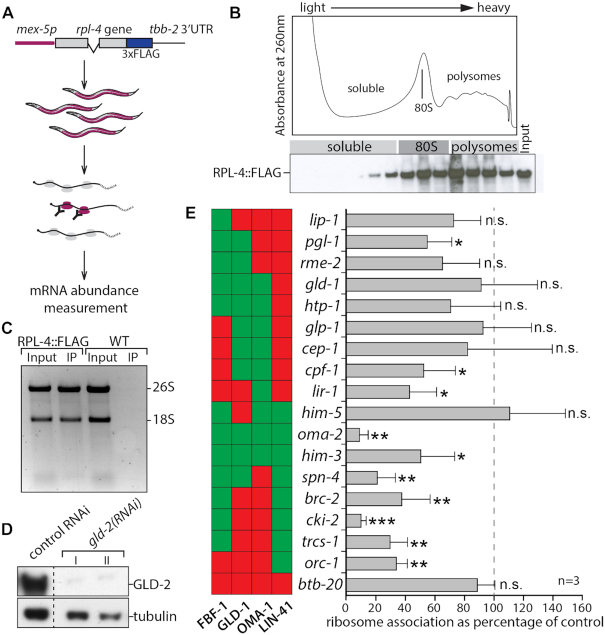Figure 6.
GLD-2 promotes the translation of LIN-41 targets. (A) Scheme of germ cell-specific ribosome immunopurification, for details see Materials and Methods. (B) Absorbance profile at 260nm of a typical polysome gradient from RPL-4::FLAG-expressing adult worms (top). Western blot of gradient fractions tested for the presence of tagged RPL-4 (bottom). The sedimentation positions of major ribonucleoprotein complexes are indicated. (C) A denaturing agarose gel of RNA isolated from anti-FLAG immunoprecipitation (IP) experiments from crude extracts (Input) of either RPL-4::FLAG-expressing or non-FLAG-expressing wild-type (WT) animals. Bands corresponding to the large (26S) and small (18S) ribosomal RNAs are indicated. (D) Western blot analysis of the indicated proteins of RPL-4::FLAG expressing animals treated with control or gld-2 RNAi. Extracts of two out of three independent gld-2(RNAi) treatments (I and II) are shown for comparison. The control sample corresponds to RNAi-treatment I. Additional lanes were removed for clarity (dashed line). (E) A selection of FBF-1, GLD-1, OMA-1 or LIN-41 target mRNAs analyzed for changes in ribosome association, comparing gld-2 to control RNAi-treated animals. The abundance of 18 mRNA was measured by RT-qPCR. Statistically significant differences are indicated and were calculated via a two-tailed Student's t-test. *P < 0.05; **P < 0.01; ***P < 0.001; n.s. = not significant; n = 3 biologically independent experiments. The color-coded columns to the left of each gene name indicates the target status of the corresponding mRNAs towards the respective RBPs (red = non-target; green = target). The complete data set of 30 mRNAs is shown in Supplementary Figure S2A.

